Life & Art
Scotch Whisky in Taiwan
Taiwan is the current darling of Scotland’s most famous export industry
By Mike Jewell
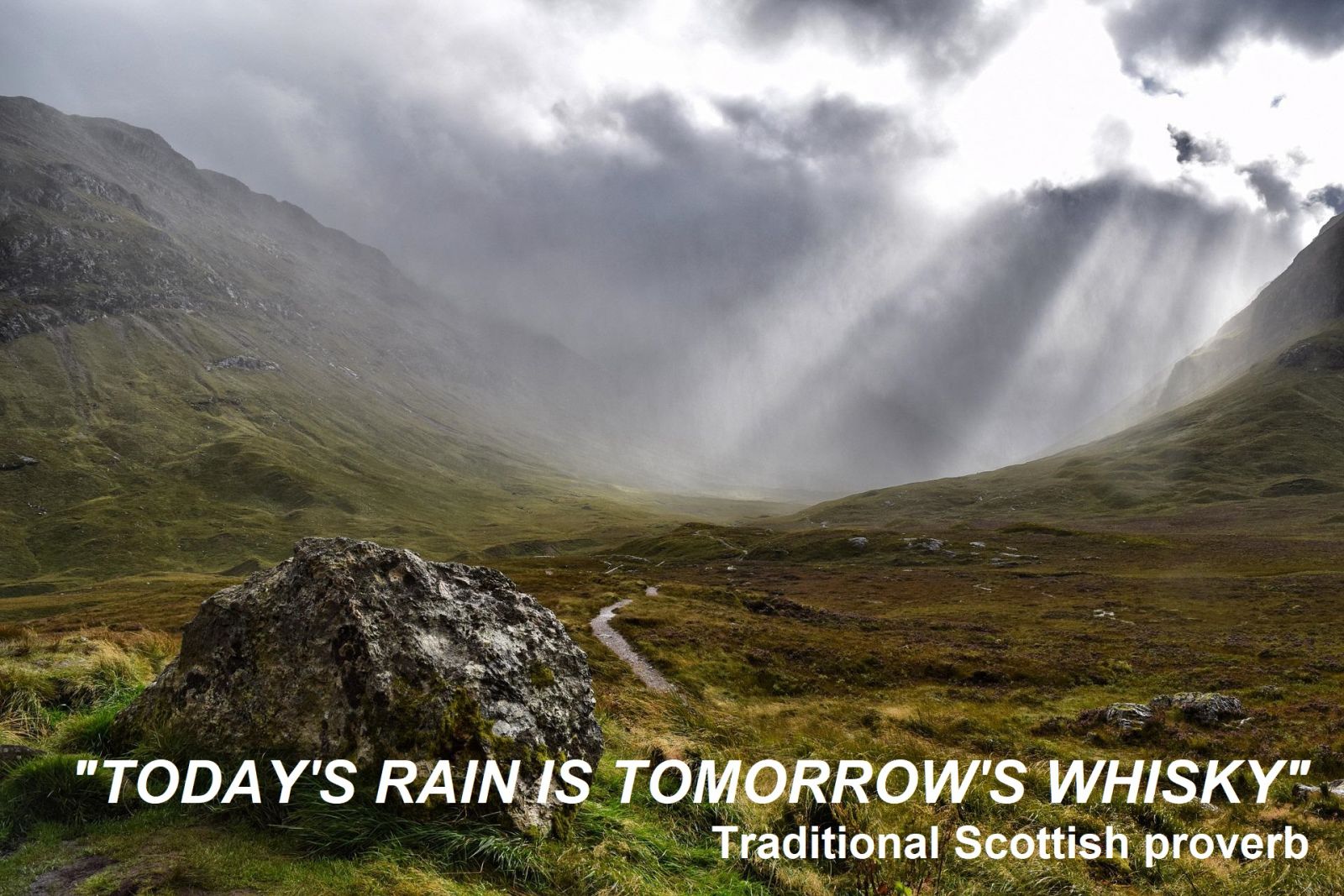
Taiwan has an extraordinary love affair with Scotch Whisky…but why?
Well, Scotch does have a fascinating history, dating back more than 500 years. It is a rich and engaging story, every bit as enthralling as a fast-paced novel or big budget action movie. Set against the wild Scottish landscapes, there are tales aplenty of mystery and intrigue, of acts of derring-do, robbery, and murder, as our heroes managed to stay just one step ahead of the relentless gaugers, the excisemen and kept producing Uisge Beatha, the Water of Life. Smugglers plied their trade in illicit bothies and even those paragons of virtue, the clergy, were known to hide Scotch under the pulpit, while the illicit spirit was sometimes even transported by coffin to avoid the taxman!
Illegal stills abounded, tucked away in remote corners of the Lowlands, or hidden in inaccessible gullies in the Highlands. Over half the whisky produced was enjoyed without the taxman taking his cut – or perhaps the occasional misplaced cask persuaded him to look the other way!
Even Scotland’s most famous poet, Robert Burns features in the plot, training as a gauger before extolling the virtues of the precious libation in his verses. He penned "Scotch Drink", an ode to whisky and the nature of happiness, of community, cooperation, warmth and a friendly welcome, the true spirit of Scotch.
By the 1800’s, distillers and government had reconciled their differences and new characters emerged, who saw an opportunity to bring Scotch to the world. Men like James Buchanan, Tommy Dewar, James Chivas and, yes, Johnnie Walker put their personal stamps on the history of Scotch and, of course, their names live on through their eponymous brands.
Even the Almighty seems to have a liking for Scotch, for, in the 1880’s, a spot of divine intervention gave a further boost to the growth of the industry. An infestation of beetles devastated French vineyards, virtually wiping out wine and cognac production. The Scots reacted in a flash and, all of a sudden Scotch became the dominant spirit, instead of brandy. Sound familiar? Read on!
Scotch is now a global product, shipped to around 180 countries, making up 22% of all food and beverage exports from the UK and worth a cool US$5 billion. According to the Scotch Whisky Association, such is the dominance of Scotch that worldwide consumption exceeds the combined total of American, Japanese and Irish whiskies.
And yet the industry still retains much of its traditional structure. Currently, there are 138 individual distilleries active in Scotland, many on the original sites of the illicit stills from more than 200 years ago.
The Glenlivet is one such example, nestled high in the hills of the Livet Valley, well away from the Strathspey Railway, and the inquisitive noses of the excisemen. A clear indication of its history of illegal distilling and smuggling, where founder George Smith learned his craft and built his reputation, which attracted the attention of brigands and royalty alike and led to violent protests from the locals when he decided to go legit and buy a licence.
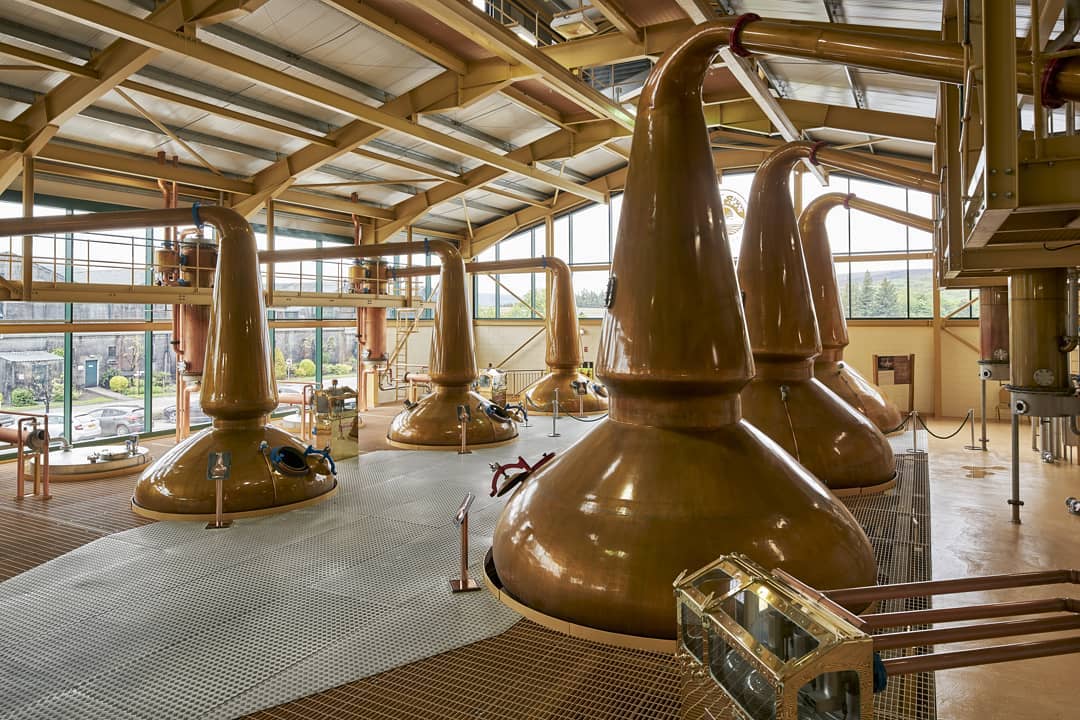
Photo credit: The Glenlivet Distillery FB page
Each distillery has its own story to tell and, though most have moved into the 21st century, with websites, online stores, visitor centres and the like, they remain true to their roots and proudly recount their histories to anyone who’ll listen and detail the genealogies of the families associated with them.
Balvenie’s website captures this deeply entrenched sense of heritage perfectly.
“The Balvenie Distillery is built on the stories that are told from one generation of craftsmen to the next. They’re our lifeblood. They are how we pass on what we know, how we process experiences, and how we create new ideas. The Balvenie Stories Range is the embodiment of these stories - tales of character written in whisky.”
Taiwan’s relationship with Scotch goes back a mere 30 years, a drop in the glass when set against the tall tales and legends emanating from Scotland’s five centuries, but, in its own way, the story is no less compelling.
When I first arrived in Taiwan in 1986, Scotch was rarely to be seen and Cognac was the imported spirit of choice for those who could afford it, but somewhere around the mid-1990’s, whisky (spelt without an ‘e’ as we’re talking about whisky from Scotland) started muscling in. The big opening for Scotch came in 2002, when the government reduced import taxes in advance of Taiwan’s entry into the WTO. The leading Scotch distributors sensed an opportunity and began investing seriously.
However, the market looked vastly different from the way it looks today. In 2002, Taiwan imported approximately 9 million litres of whisky from all sources. The effect of the tariff changes was to increase imports by around 43% in a year and, despite some fluctuations, that volume growth has been maintained, so that, in 2021, total imports were 22.5 million litres. And the one constant throughout has been the complete domination of Scotch over whiskies from all other countries. Currently, 9 out of every 10 glasses of whisky consumed in Taiwan hail from Scotland. So important is Taiwan to the industry that Scotch even gained formal trademark protection in 2016.
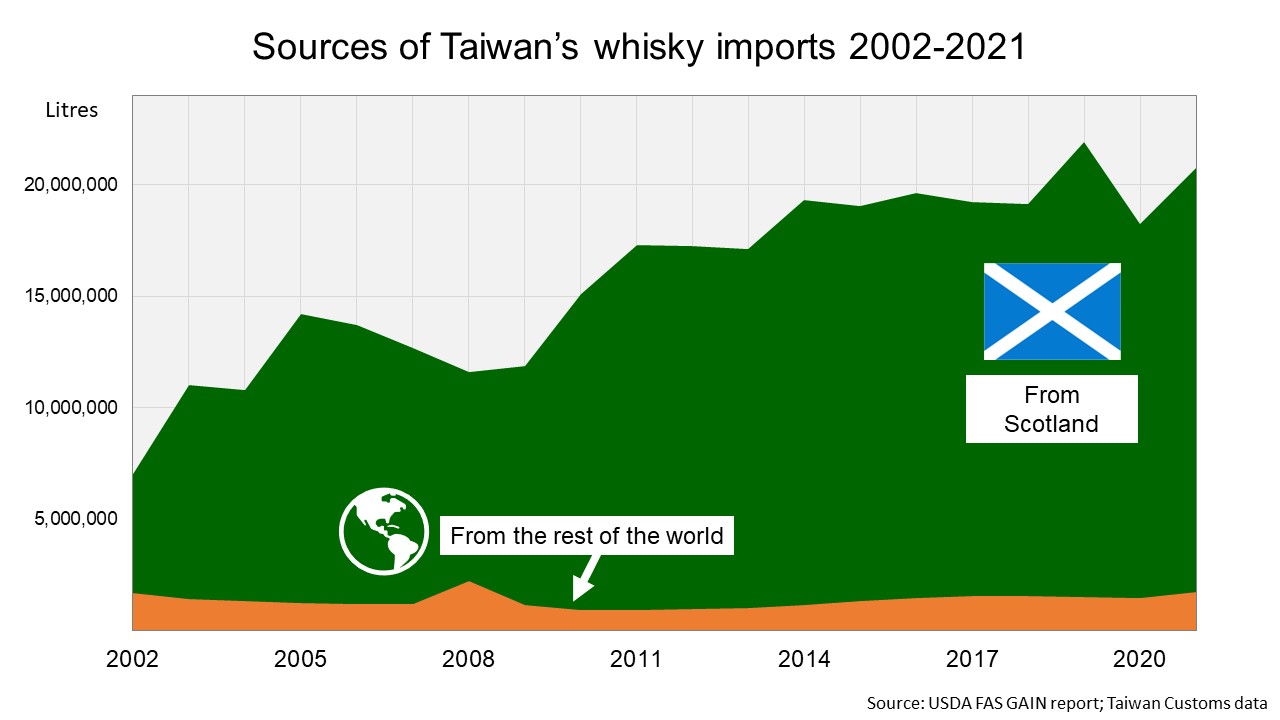
Impressive as these volumes are, they only tell a small part of the story. The real jaw-dropper is the total value of the Scotch coming into Taiwan. In the period from 2007-2021, as the amount of Scotch imported jumped by 64%, the value of these imports soared by 196%! According to the Scotch Whisky Association, Taiwan is the industry’s third most valuable market. The 29 million bottles of Scotch we order every year don’t get us anywhere near the global top ten for the amount of whisky, but the sums of money we spend makes us very dear to the distillers and producers back in Scotland. (Note, I keep saying ‘we’ because I am partial to a wee dram myself from time to time.)
So what makes Taiwan so special?
It has been a rapid journey of exploration and discovery, not unlike Taiwan’s own evolution. Today Taiwan’s market is unique, in that around 50% of the market is single malt Scotch, whereas the norm globally is just 15%.
But it wasn’t always so. In the 90’s, purchasing was focused on a few big brands of blended whisky which, through extensive marketing by the major global beverage companies, were able to establish strong awareness and broad distribution. Price was often a key driver, with higher prices denoting superior quality. Consumers knew little about whisky, but those who drank it did so because they could afford it and because it was the thing to do. At that time, single malt was no more than 5% of the market.
Things began to change, however, when established brand names started looking for an extra edge and the addition of the descriptor “malt” to a brand became all the rage. Mike Cottingham, founder of the Cottingham Group, a leading importer and brand ambassador for several leading Scotch brand, explained what happened in an interview with “Whisky Investment Direct” in 2020.
"Between 2002 and 2005, we took Ballantine’s Pure Malt from 600 cases per year up to 28,000. We did that by emphasising that this was malt whisky (even though the consumer did not know what 'malt' was). We simply told them that this was 100% malt, whereas blends were only 50% malt."
This shift towards vatted or blended malts was far from the end of it, of course and Taiwan soon discovered a fascination for single malt, bringing us to the position we are in today, one of the most sophisticated whisky markets on Earth. Whisky drinkers these days are very different from their predecessors in that they have developed their knowledge through a desire to learn and appreciate the qualities of different whiskies.
This is clear evidence of Taiwanese consumers maturing, moving in a different direction from established norms with the confidence and curiosity to discover what they really like, rather than following the crowd. There are now many genuine whisky connoisseurs with well-developed palettes and a real depth of understanding of the products. There has been a similar trend with the growth of craft beers, and the development of the market for fine wine.
According to Pernod Ricard Global Travel Retail Marketing Manager for Malts Laura Lung
“Taiwan is a lead market in the world of single malt and its consumers are discerning and advanced in their knowledge’.”
Evolving tastes have been accompanied by a similar evolution in the profile of Scotch drinkers who now encompass a much broader swathe of the population than before. Whisky is still popular with businessmen in “traditional trade” bars and night clubs and for repeatedly toasting each other’s health at banquets, but there is also a new generation of consumers – younger, professionals, both male and female, who enjoy drinking at home, as much as they do socialising outside in restaurants, clubs, KTVs and especially in the growing number of specialist whisky bars. Happily for the distillers and producers, Scotch consumption is not limited to just one or two particular occasions, but, for this new generation, is the drink of choice for any number of situations.
The momentum behind Scotch is further being driven by major industry events and by any number of more intimate tastings often hosted by well-known whisky specialists (so-called KOL’s). In the view of Steven Parker, CEO of Cottingham Group, this type of session fits particularly well with the way Taiwanese approach their hobbies and interests. He explained that Taiwanese are eager to learn and build up a detailed knowledge of the category, which they can share with friends. Equally these tastings fulfil an important social role in a society where it is not common for individuals simply to “go to the pub” and engage strangers in conversation, as often happens in many western societies. In Taiwan, tastings give individuals a reason for going out and provide a framework and focus for discussing a common interest with like-minded people with whom they wouldn’t normally engage.
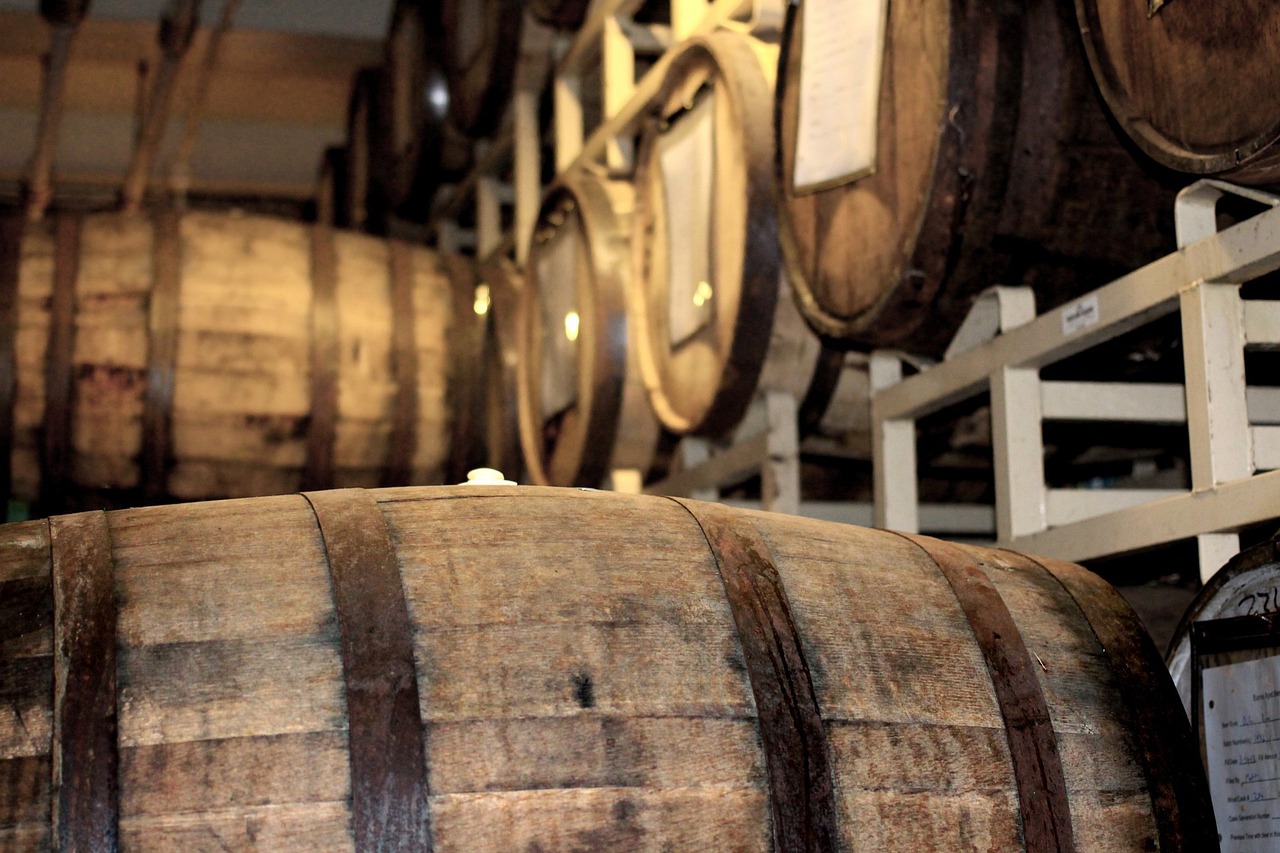
Image by PublicDomainPictures from Pixabay
The growing maturity of consumers’ tastes, allied to their relentless desire to delve ever deeper into the world of Scotch has resulted in tremendous fragmentation of the market, with distillers and producers falling over themselves to slake Taiwan’s thirst, with an ever expanding portfolio of single malt options.
Steven Parker told me he thought Scotch is far better placed than any other spirit to align with Taiwanese consumers because of the myriad of variations single malt encompasses. First of all there are the 138 distilleries dispersed across the various regions of Scotland – the Lowlands, the Highlands, Speyside, Islay, the Islands, and Campbeltown – and each with their own distinctive style. Then there are the woods of the casks the whisky is matured in – sherry casks, bourbon casks, wine casks – and some whisky is matured in just a single cask, but others are double- or even triple-casked. Consumers relate to these alternative options and firmly believe they can differentiate between them and eagerly anticipate each new introduction.
And then there is the age of the whisky. To be recognised officially as Scotch, the liquid must be matured for a minimum of three years and one day before bottling. However, a three year old whisky would find very little favour in Taiwan. Eight years is the bare minimum, but consumers tend to focus on older brands and a range of ages can be found in most retailers. We’ll return to the ageing of Scotch later.
Yet more choice comes from the offerings of the independent bottlers. The established distilleries and their parent companies sell the output under the names of the distilleries – major names like Balvenie, Glenfiddich, Macallan, Glenlivet, Glenmorangie etc. as well as many others, some owned by the major international beverage companies, others completely independent. Then there are leading independent bottlers, such as Gordon & MacPhail, Douglas Laing, and Signatory, who operate like the wine negociants in Burgundy, buying casks from individual distillers and selling them as part of their own range, with reference to the original distillery or creating a whole new brand with its own distinctive characteristics and flavour.
Every single one of these variations comes with its own particular story, a small tale that captures the imagination of the consumer and gives him or her that little extra reason for choosing it. Each one represents a small part of the history of Scotch, the five centuries of development, the stories, the culture, the romance, the dedication of the master blenders.
Amidst all this discussion of single malts, it is easy to overlook the fact that the various iterations of Johnnie Walker and Scottish Leader, both blended whiskies, account for almost 30% of the whisky drunk in Taiwan, but there is no getting away from the fact that the Scotch whisky industry loves Taiwan because it is an educated market, with lots of whisky connoisseurs interested in premium products.
Such is the industry’s desire to please the Taiwanese consumer that many exclusive offerings are developed specifically for Taiwan, such as The Glenlivet 13 Year Old Sherry Cask, Macallan Boutique Collection, Dalmore 20 Year Old, and Glenfarclas 180th Anniversary. Producers such as Deanston also refine their blending to suit the predominant taste preference for a smoother, slightly sweet and not overly smoky flavour.
Turning back to the ageing of Scotch, the market seems to be entering a new phase, in Steven Parker’s words “transitioning from consumables to collectables”, at least at the very, very top end. Buyers in Asia, including Taiwan are at the forefront of this trend.
It is an extraordinary fact that warehouses in Scotland currently hold a stockpile of 22 million casks of various ages, some going back almost 100 years. That equates to 12,000,000,000 bottles, just waiting for the right moment to be filled and despatched to market. Fortunately, the Scots have scrupulously documented the age and origin of every single cask, so that, when the time comes, a detailed record of the heritage of each one will be on hand to reassure the enthusiastic buyer that their money has been well spent.
So far, on my admittedly limited wanderings round the wine shops of Taipei, a 40-year old Balvenie is the most expensive bottle I have come across, a steal at NT$229,600!
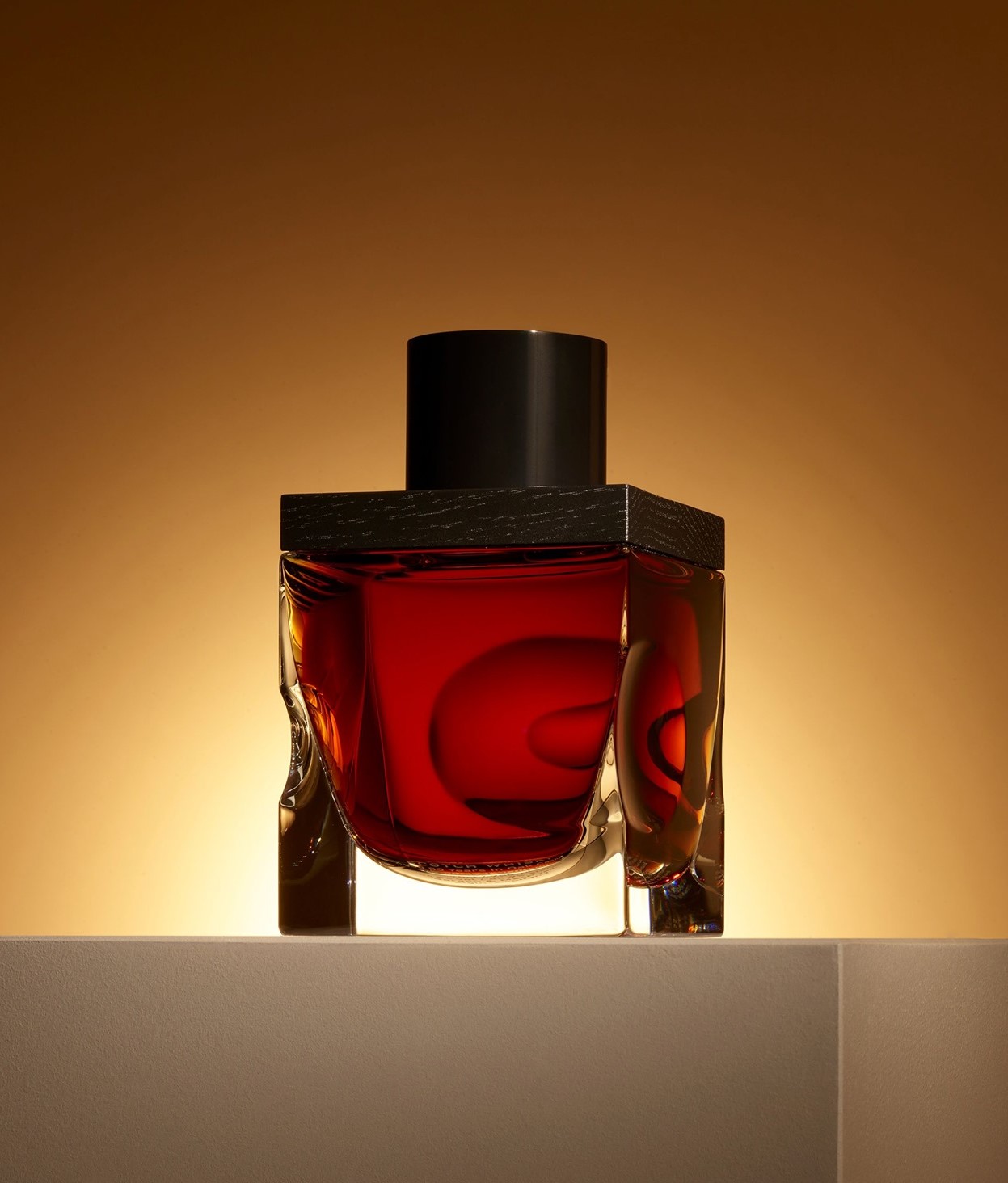
Photo: Gordon & MacPhail FB page
However, this is relatively modest compared with the oldest whiskies available. In 2021, the first decanter of Gordon & MacPhail’s Generations 80, from Glenlivet Distillery, which was put into cask in 1940, sold at auction in Hong Kong for US$193,000. Writing on The Decanter website, Richard Woodard commented:
“As any whisky lover will tell you, age isn’t everything. The most remarkable aspect of the Generations Glenlivet is the fact that the whisky is still so damned good after spending eight decades in an ex-sherry cask.”
At that time, the Generations 80 was the oldest Scotch ever sold. It has now been trumped by Macallan’s “The Reach”, 81 years old and available for US$125,000 a bottle.
These two are the latest headline acts at the very pinnacle of the market, but a number of producers are actively involved in bringing highly desirable, exclusive collectable Scotches to market and it will be fascinating to see how the producers manage their enormous stockpile.
Slainte!